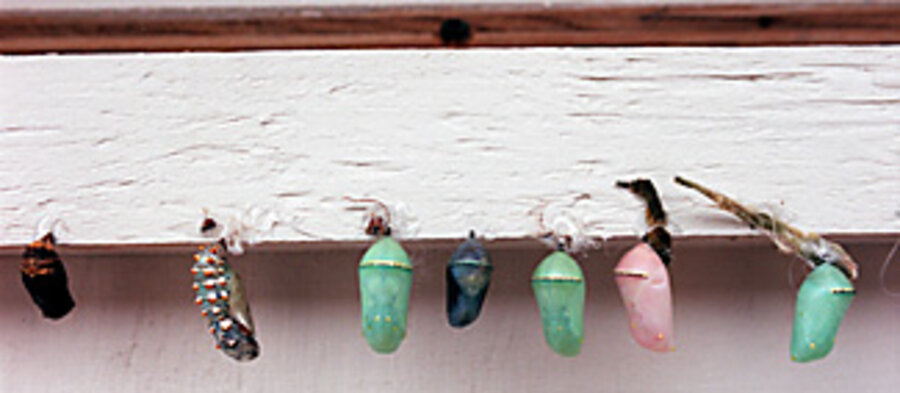Of milkweed and monarchs
Loading...
My butterfly story started in late spring. My daughter and I were walking our dogs in the park when we came across a table set up by schoolchildren offering free seeds in little manila envelopes. "Asclepias curassavica 'Tropical Milkweed' – host plant for the Monarch butterfly," the packets read, along with a small picture of a butterfly. A sign explained that the monarch habitat had been virtually wiped out in our suburban city due to construction.
The students had started a project to bring back the butterflies by encouraging residents to plant milkweed, the only food the monarch caterpillar eats. My yard already housed six hens, two rabbits, numerous wild birds, and an opossum. Why not a butterfly? I took a packet of seeds home and planted them.
The seeds came up and the plants grew, despite my neglect. In a few months, I had four milkweed plants that were three feet tall in a pot that I kept along the path that led to our outside trash cans. One day when taking out the trash, I noticed a butterfly on one of the plants. I was amazed! How had that wandering monarch found my pot of milkweed? I stared in wonder at the beautiful orange wings outlined by black and a pattern of white dots. All too soon, it flitted away.
Some time later, in early December, I was again taking out trash when I suddenly noticed a caterpillar with black, yellow, and green stripes on the milkweed. A search revealed another. The butterfly had laid eggs! I worried about the rain killing the caterpillars or my chickens eating one. "You shouldn't interfere with nature," my teenage son reprimanded as I brought the milkweed plant inside and set it on the kitchen counter. But I felt as if these special little creatures were somehow in my charge.
Daily I watched the caterpillars munch on the milkweed leaves until one day, the larger one stopped eating and hung itself in the shape of a 'J' from a leaf. In a day or two, it wriggled its way out of its skin and formed a shiny green chrysalis. Tiny gold dots lined the top third of the chrysalis, like jewels on a crown.
A few days later, the other caterpillar changed. For two weeks they hung in their cocoons on my kitchen counter. I would look at them and wonder, what's going on inside those hanging green gems? Then the older chrysalis began to darken, and I could see the folded wings inside. Even my ever-cynical son couldn't help being impressed. "How'd it do that?" he asked. I eagerly waited and watched for my butterflies to hatch, stopping between chores to check the cocoons.
I was upstairs changing sheets on a bed when my daughter called suddenly, "You missed it! The butterfly's out."
I ran down and sure enough, from the now clear, empty chrysalis hung a monarch butterfly. "It's amazing it ever fit inside that little shell," my daughter said. I felt awed by the transformation.
The wings were wrinkled but soon straightened out. Not wanting the butterfly to fly into the window, I moved the plant outside, under the cover of our patio swing.
It was a few days before Christmas. Here in California, it had rained the night before and looked on the verge of more rain. The butterfly stayed on the plant all day, drying its wings, and the next day, it flew away.
The second butterfly didn't hatch until a few days before New Year's. It hung on a leaf, wings closed, for more than three days. Then the sun finally came out. Warmed by the light, it repeatedly pumped its wings. The inside of the wings was even more beautiful than the outside – a deep, rich, velvety orange.
I resisted the urge to touch them. Did they feel as soft as they looked?
Finally, it, too, flew away. I wished it had stayed longer. The butterflies had brought everything to me the season was supposed to hold: wonder and amazement, but most of all, hope in the potential for change.
January is the time of year when everyone wishes for newness. Ads for diets and exercise machines monopolized the airwaves. People made resolutions to do better. There were many areas of my life that I, too, wanted to improve. So I placed the empty chrysalis on my kitchen counter, a daily reminder that perhaps both the desire to change and the ability to do so are inherent, and if a caterpillar can become something so wonderful, certainly so can I.





